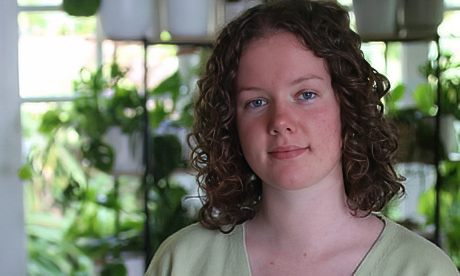Megan Dykes’s TikTok account is a dark place.
On a recent Thursday morning, she opened the ‘For You’ page on the app and lingered over the first video that popped up: a clip of a young woman joking about wanting to cut herself.
Dykes (pictured) swiped her thumb and watched another similarly gloomy post, and then another.
She kept scrolling, and the videos kept coming — a seemingly endless stream of depressed and distressed young women venting about how lonely and worthless they felt.
Dykes, a 20-year-old university student in Wellington, has watched so much of this kind of negative mental illness-related content on social media in the past decade that she is to some extent desensitised to its emotional impact.
But as she scrolled, she couldn’t help despairing.
“I just feel angry,” she says.
“A whole generation of kids is being raised on this content.”
Dykes has a complicated history with social media.
A decade ago, as an adolescent in Auckland, she began experiencing what she describes as a mild case of depression.
In her recollection, Dykes was a slightly awkward child who didn’t have a lot of friends and struggled to fit in at school.
She went online and found some “very intense” material relating to depression.
Dykes says her parents put few restrictions on her internet use and didn’t realise what she was looking at.
Some of the material she found was very explicit, but she was drawn to it.
On Google Plus (an early competitor to Facebook that is now defunct), she first came across references to self-harm.
Within a year, Dykes says she was regularly self-harming and having suicidal thoughts.
It took Dykes years to get over these experiences; in some ways, she is still dealing with them.
Looking back now, she says her depression would not have become as bad or lasted as long as it did, or she may not have started self-harming, had she not fallen into those dark corners of the web.
“It was so much harder to get out of it after becoming stuck in that space,” she says.
Rising rates of distress
In the past dozen or so years, rates of anxiety, depression, self-harm, and other mental health conditions have increased sharply among adolescents in New Zealand and other high-income countries.
At the same time, the amount of material dedicated to these problems on social media has exploded.
A generation of youngsters who have never known the world without smartphones or the internet turned to social platforms for information and advice about mental health conditions and treatments, to seek validation and support from others with similar experiences and to express their anguish.
In many ways this has been beneficial, raising awareness of the importance of mental wellbeing, encouraging people to seek help and inspiring recovery.
But there is also an astonishing amount of material on social platforms that users, researchers and clinicians say is potentially harmful to vulnerable adolescents — spreading misinformation about mental health conditions, encouraging self-destructive behaviour and trapping users in a spiral of hopelessness.
As part of a major investigation into the state of mental health in New Zealand, the Herald has spent months interviewing young people who have been immersed in this content, parents, clinicians, researchers, health officials, regulators, and others; reviewed dozens of academic studies on the subject; and examined thousands of posts on several platforms.
Last month, NZ Herald reported on a network of young women with severe mental illnesses who used private accounts on Instagram to share intimate details about self-harm episodes, hospital admissions and suicide attempts.
Three of those young women died by suspected suicide in 2019, prompting an ongoing inquiry by the Coroner’s office.
But while concerns remain about Instagram, serious questions have also been raised about the impact of TikTok, its Chinese-owned competitor (TikTok is controlled by a company called ByteDance).
It commands a growing share of young people’s attention and has become, for many teens, the primary platform for viewing and sharing information about mental health.
“I think TikTok has completely changed the game,” Dykes says.
An internet juggernaut
It is hard to overstate the influence that TikTok, in just a few years, has had on how teens communicate and entertain themselves.
Based on a lively, easy-to-use app that showcases short, looping, often humorous videos made with catchy audio clips and visual effects, TikTok makes it possible for users to reach vast audiences with minimal effort.
Billions of homemade videos have been uploaded to the platform on a dizzying range of topics, spawning countless memes and a new generation of influencers.
Its most compelling feature is a powerful, algorithm-driven recommendation engine that quickly discerns a user’s interests and uses this to populate a personalised stream of videos.
Without even looking for something to watch, a user can stay glued to the app for hours and see dozens, if not hundreds, of clips in that time. Continue reading
Where to find help and support:
- Anxiety New Zealand 0800 ANXIETY (0800 269 4389)
- Depression Helpline – 0800 111 757
- Lifeline – 0800 543 354 or (09) 5222 999 within Auckland
- Mental Health Foundation 09 623 4812
- Need to Talk? – Call or text 1737
- Rural Support Trust 0800 787 254
- Samaritans – 0800 726 666
- Shakti Community Council – 0800 742 584
- Shine (domestic violence) – 0508 744 633
- Suicide Crisis Helpline – 0508 828 865 (0508 TAUTOKO)
- thelowdown.co.nz Web chat, email chat or free text 5626
- What’s Up – 0800 WHATS UP (0800 942 8787)
- Women’s Refuge – 0800 733 843 (0800 REFUGE)
- Yellow Brick Road 0800 732 825
- Youthline – 0800 376 633, text 234, email talk@youthline.co.nz or online chat
